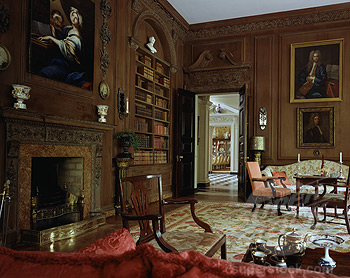The Transformation of the Gentleman’s Study
.jpg) Albrecht Dürer, "St. Jerome in his Study" (engraving), 1514
Albrecht Dürer, "St. Jerome in his Study" (engraving), 1514
[>>British Museum, London]
What a change has taken place between the modest workplace depicted by Albrecht Dürer and the eighteenth-century gentleman’s study! The bare ceiling, stone walls, and planked floor have been replaced by delicate plasterwork, wallpaper, and a fitted carpet. Instead of small, blurred panes the windows contain large pieces of clear glass, and their frames slide conveniently up and down for ventilation. There is much more furniture, and a larger variety of it: special chairs for writing at the desk, easy chairs with padded arms for reading, a sofa for conversation, low convenient tables. What is more, this is furniture designed for relaxing in, quite unlike the hard back-stools and plain benches of two centuries before. Even the table for writing is made especially for that purpose. No longer improvised out of planks laid on a demountable trestle, the desk is a delicately carved mahogany [124] box with a curved front that slides smoothly back to reveal useful-looking drawers and pigeonholes. Upright commodes with drawers have replaced chests; books are kept in tall cupboards with glazed doors. The overall effect, seen through Dürer’s eyes, is one of an increased density of objects and decoration and also a pronounced softening effect, due not only to the upholstered furniture, but also to the patterned paper that covers the walls, the heavy cloth that is draped over the library table, the curtains drawn apart on each side of the window, and the soft carpeting on the floor.
The end of the eighteenth century marks a point roughly halfway between Dürer’s time, where we began, and the present day. Histories of furniture tend to focus our attention on the evolution of design and ignore the more fundamental issue of ownership. The achievement of the eighteenth century was not just the production of comfortable and elegant furnishings, but their availability to a broad clientele. This fact would have impressed Dürer the most; this level of comfort was present not in a royal palace, but in the home of a moderately well-off family. That a private individual might personally own dozens, if not hundreds, of books would have astounded Dürer, as would the idea of devoting a special room in the home exclusively to writing and reading.
.jpg) Chamber Pot
Chamber Pot
[>>Victoria and Albert Museum, London]
Yet from our vantage point, a surprising number of things had not changed at all. The Georgian study was still heated — and not very effectively — by an open fireplace, or, if it was on the Continent, by a porcelain stove not much different from what Dürer had been accustomed to. The writing desk was elegant, no doubt, but people still wrote with a quill pen dipped in ink. At night, they read uncomfortably by candle-light, just as Dürer had done two hundred years before. If a letter writer wished to wash his ink-stained hands, he was obliged to call a servant for a bowl of water — there were no [125] sinks or plumbing. Nor were there bathrooms — a small cupboard in the corner contained a chamber pot.
[Excerpt from Witold Rybczynski, Home (Penguin, 1986), chapter 6 (“Light and Air”), pp. 123-25]
